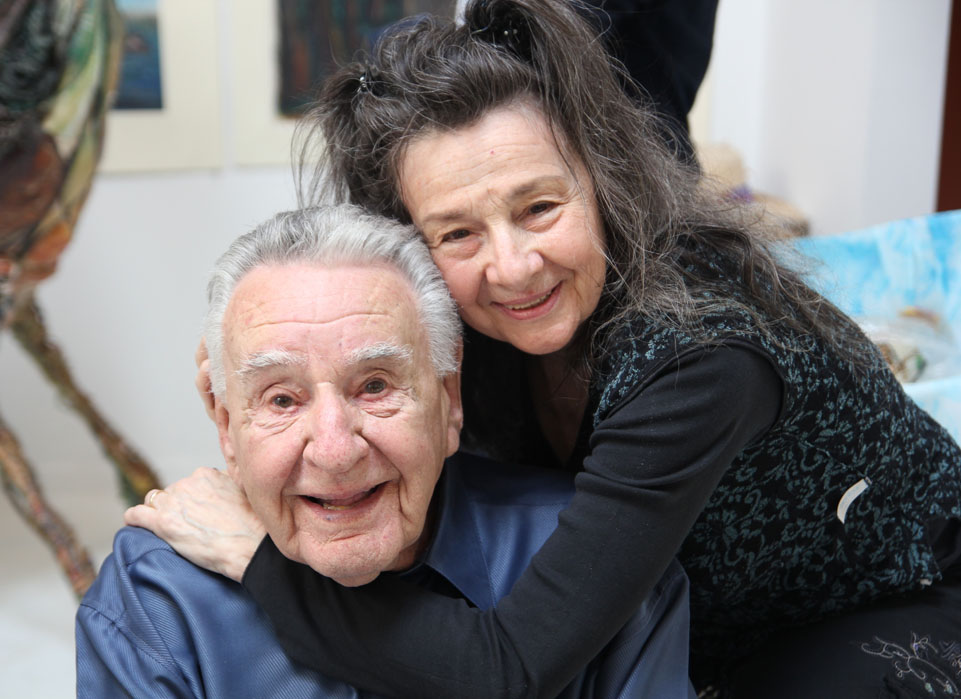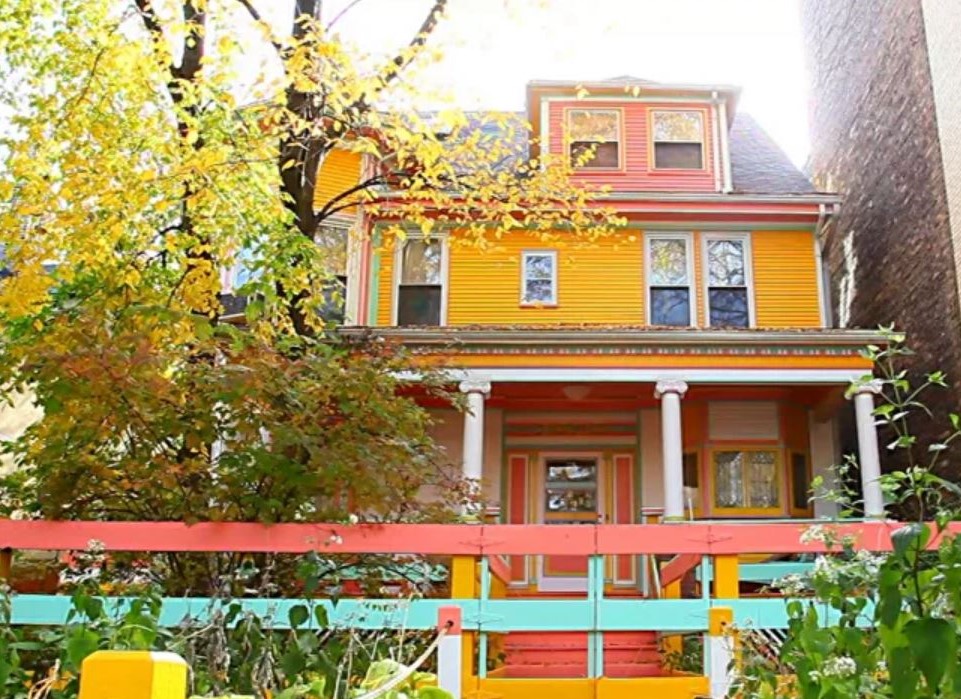September 16, 2019
Thank you to all the friends and colleagues who submitted the below reminiscences and notes in memory of Don Seiden. Special thanks goes out to Dan Anthon ATR-BC and Mary Andrus DAT, ATR-BC, ATCS, LPC, LCPC who coordinated and organized this article and to Randy Vick MS, ATR-BC, LCPC, HLM for writing the introduction with details of Don’s life.
The School of the Art Institute of Chicago (SAIC) Art Therapy department will host a memorial event on Tuesday, September 24th from 5:30 pm to 7:30 pm in the Maclean Ballroom, 112 S. Michigan Avenue. You are invited to register for this event on the SAIC Art Therapy blog
.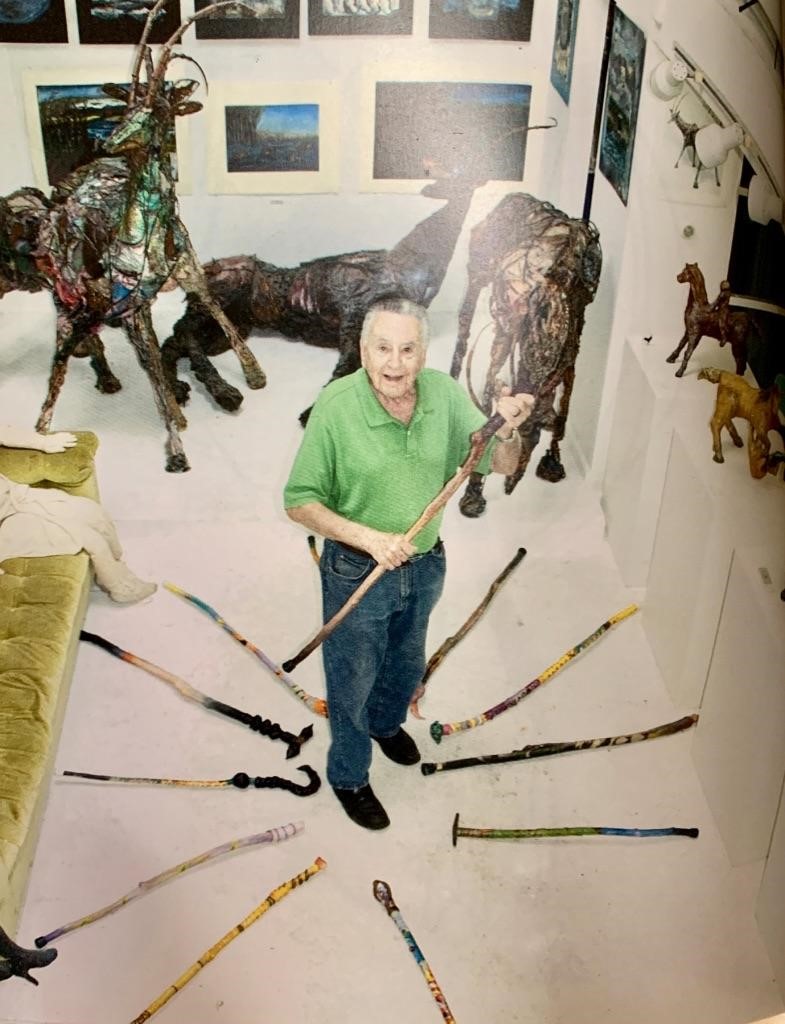
“An Artist’s Life” by Jane Stevens
Randy Vick MS, ATR-BC, LCPC, HLM
Professor Emeritus Don Seiden, a pioneer in the field of art therapy in the Midwest and innovative educator passed away on August 8th 2019, two days past his birthday.
After returning from his service in the U.S. Navy, Don pursued his art degree at Chicago’s Institute of Design (now part of the Illinois Institute of Technology) on the G.I. Bill. There he was exposed to the inventive “New Bauhuas” concepts being introduced by Bauhaus master educators such as László Moholy-Nagy and Ludwig Mies van der Rohe. These experiences shaped Don’s approach to artmaking throughout the varied career that would follow. He studied photography and graduated in 1959 with an art education degree.
After college, Don worked as a high school art teacher and began learning about the artistic potential of welding. Don’s life-long commitment to his art lead to his participation in over thirty-five solo and group shows, including a retrospective exhibition at the Illinois State Museum Chicago Gallery in 2011. He worked in all manner of traditional and nontraditional media producing drawings, paintings, and photographs but his primary focus was mixed-media sculpture.
Key works include a chess set done on human scale and a family of antelope. Perhaps his most iconic sculpture is a life-sized rhinoceros created with aluminum foil and duct tape over a welded steel armature. This is a monumental version of Don’s signature “tape & foil” method in which crumpled aluminum foil becomes the armature that supports a masking tape “skin” that is latter painted. More recently, he created a series of mixed media birds that were installed in a lakefront park.

Don’s life sized chess set
For Don, life and art were always inseparable. The home he shared for decades with his wife Jackie on Chicago’s northside became a Gesamtkunstwerk, filled and embellished by their creative efforts. True to his generous nature, he often opened his home to students, filmmakers, and other guests for inspiring tours.
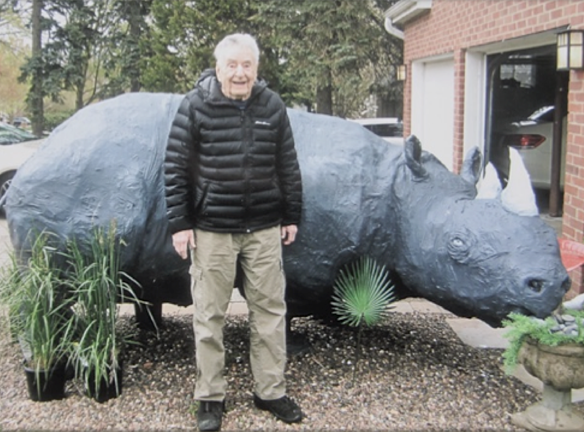
Don and his rhino
His experience as an educator and sculptor lead to an opportunity to teach temporarily in the Sculpture department at the School of the Art Institute of Chicago in 1962. He later became a full-time, tenured faculty member in that department but eventually shifted to the Art Education department. During this time he also worked as an art instructor on the psychiatric units at Rush-Presbyterian-St Luke’s Medical Center. It was an era when formal art therapy education was in its infancy and through his experiences with patients and the staff education offered at that training hospital, Don formed his identity as an art therapist. He became a Registered Art Therapist through the American Art Therapy Association.
While teaching in the Art Education department, Don began to offer some introductory art therapy courses and in 1979 a post-baccalaureate art therapy certificate program was launched. Working in consultation with colleagues from Rush, a 60-credit Master of Arts in Art Therapy program was instituted in 1985, with students taking some of their coursework alongside students at the medical school. The MAAT program was approved by the Education and Program Approval Board of the American Art Therapy Association in 1989. While it has evolved to reflect changing times and credentialing standards, it remains the longest established professional art therapy program in Illinois. Although he retired from the School in 2005, Don’s vision of the artist/art therapist remains a central philosophy of the program.
Don’s influence extended beyond SAIC. He has authored a number of books and articles on art, art education, and art therapy and has been the subject of several video biographies. Don also helped establish the Illinois Art Therapy Association in 1974 and was named a Regional Pioneer by the American Art Therapy Association in 1997.
For the generations of SAIC students who were fortunate to have had Don Seiden as a teacher, he is remembered as an earnest and gentle spirit devoted to a full investment in art and humanity. This commitment continues on in the hearts of those he has taught, mentored, and inspired. This will be Don’s greatest professional legacy.
Funeral services were private. To honor Don, his family “invites you to make art, support the arts, appreciate and enjoy nature, and support our national parks; most importantly, continue learning and trust the process and journey through life.” A formal obituary and online condolence book has further family details.
Jose Alcantra, ATR
 I kept an old note Don wrote as feedback on my art progress. It was short, direct, concise and simple, in many ways that is how I will remember him. He somehow showed us young students the very core of creativity requires a simplistic, reductive approach. It stripped away any pretentiousness in art making and reminded you that you and your art come from an ancient origin. Your sole duty is to give form to your experience, shape your story with whatever you got. Don was a true teacher and provided us students a quiet reminder of the power and majesty of art.
I kept an old note Don wrote as feedback on my art progress. It was short, direct, concise and simple, in many ways that is how I will remember him. He somehow showed us young students the very core of creativity requires a simplistic, reductive approach. It stripped away any pretentiousness in art making and reminded you that you and your art come from an ancient origin. Your sole duty is to give form to your experience, shape your story with whatever you got. Don was a true teacher and provided us students a quiet reminder of the power and majesty of art.
He was a welcome sight, especially as a student immersed with all the “learning”, and in comes Don with his found materials and duct tape and endless rhinos and antelopes. One memory that comes to mind, a student asked how he decided to make the antelope lean so beautifully: Don replied, “One morning it collapsed on its legs so I just kept it that way.”
We have two new students from SAIC and Yuri, a recent grad from SAIC just ran her first ET group with adolescents with the two students observing- what a poignant moment to see the legacy we are building for future “awesome” art therapists. Don lives on in our work daily.
Image: Jose Alcantra, Director of Expressive Therapy; Peta Minerof-Bartos; Intern; Alyse Ruriani: Intern; Yuri Kim; Art Therapist
Pat B. Allen Ph.D, ATR-HLM
The first time I saw Don present a slide show of his art was at an IATA meeting not long after I’d moved to Chicago in 1980. I was thrilled and amazed to find another person whose personal art followed the same principles he used as an art therapist. This was rare in art therapy in those days. Don showed slides of a massive sculpture of a woman’s body that people could walk inside, he had many sculptures of demons, and other quirky beings. In sum, he was dealing with his own deep psyche and was completely okay with sharing this in public. I sat in the darkened room with tears in my eyes, having found a kindred spirit. Over the years, he made animals, including his iconic rhino and herd of antelopes became stand-ins for the same truths.
It surprised me that the first thought I had on hearing Don had left this mortal realm was: “Wow, the death of the patriarchy is really underway.” I never experienced Don as sexist, egotistical or domineering, characteristics I associate with patriarchy, so where did that thought come from? Don created the art therapy program at SAIC at a time when his peers, mostly men, who headed the departments at the School, objected to art therapy in an art school. Looking back it is kind of miraculous that he made it happen, he exercised power in whatever subtle way he needed to among his fellow artists to make a place for something they thought honestly, was ridiculous.
He used his power, something those of us who knew him never saw him wield in arrogance, to serve the creative source, to make a place for the healing power of art in a big deal art school. I believe that through his art he was able to manage a personal integration and balance of powers that he could then manifest in the world. May we all take a lesson from Don.
Mary Andrus DAT, ATR-BC, ATCS, LPC
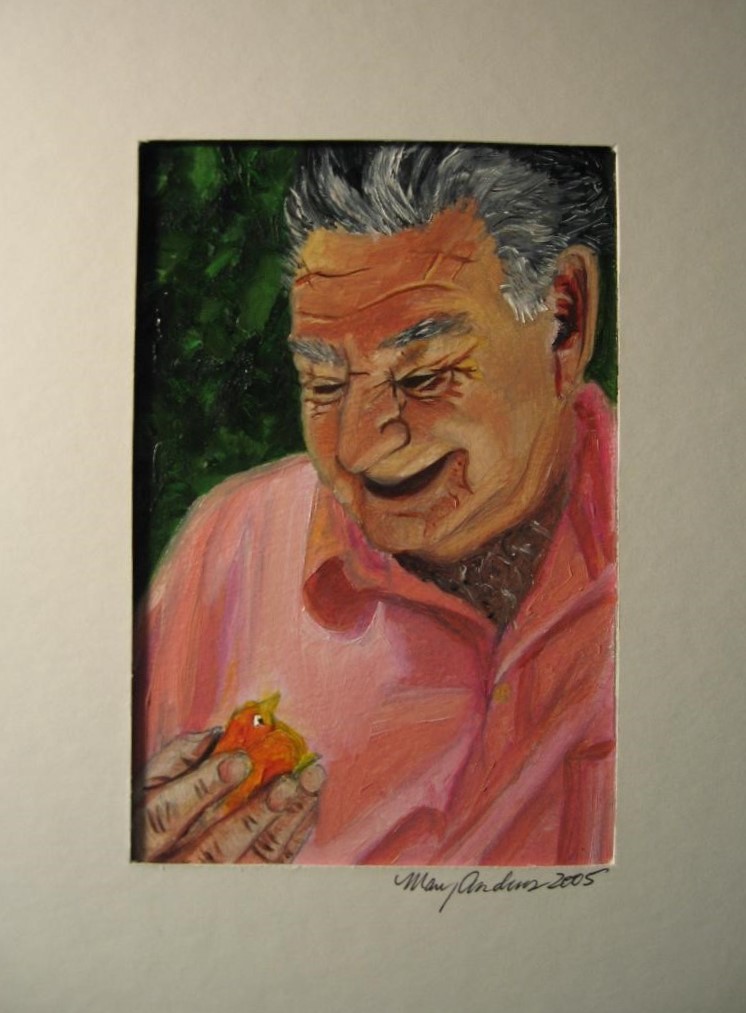 I will treasure our long talks on how art will someday save the world. I am grateful to have had the time documenting his profound insights on art and life. He has left the world in a better place because of what he did, who he was and how he made people feel.
I will treasure our long talks on how art will someday save the world. I am grateful to have had the time documenting his profound insights on art and life. He has left the world in a better place because of what he did, who he was and how he made people feel.
Don saw me, the real me. When he looked at my art, it felt like a warm hug. By example, he taught me how to be present with myself and with others. He reflected back to me parts that I want people to know, but don’t know how to bring out on my own. He welcomed my most vulnerable art into his heart and acknowledged its power, metaphor and reflected unspoken depth. He’d sigh and say “wow” and with a twinkle in his eye I felt understood and unconditionally embraced.
He was an extremely humble man and tried to stay out of the spotlight. He allowed his art to speak for him. His beliefs, values and connection to his art process reached beyond the usual rituals and habits for most people. He modeled an intense commitment to his own process with trust and a belief beyond his conscious awareness. He led by example, he set forth a path of devotion to making art when he had big emotions. He allowed himself to explore deep raw uninhibited aspects of himself. In doing so, he gave us all permission to look deep within ourselves. His commitment to exhibitions paved a path for art therapy in the Midwest to value the importance of the artist self, building community and inspiring others.
He may have physically departed, but his legacy and impact is exponential and will continue in all of us.
Image: “Don,” Oil on paper, 2005 by Mary Andrus
Dan Anthon ATR-BC
Don Seiden. It’s impossible to put simply his contribution to the field of art therapy. He was a pioneer of art therapy, training many hundreds of art therapists who dispersed all over the Untied States and the world. His influence was sustained, affective and unique. Don forged a long-term relationship with Rush Medical Center, where he worked on various psychiatric units for many years and eventually aligned with its medical school, who’s doctors taught the psychiatric component of his newly created art therapy department. As an intern and then employed art therapist at that same institution, years after Don left, I saw his contribution embedded in that institution’s history. He was an indomitable force to the thousands of people he touched.
Don was a teacher, in the most multifaceted understanding of that occupation. The SAIC program, was, and remains centered in the arts, students are still required to take studio classes from the art school curriculum. He was a beloved professor and colleague, even though many of his peers were chagrined at his movement toward art with the mentally ill. During the late 1980’s, Don organized an array of prominent individuals, spanning careers in psychiatry, art history, art education, artists and art critics. “Art and the Brain” included the prominent author of “Drawing on the Right Side of the Brain”, Betty Edwards. My belief is that Don gathered this auspicious panel of experts, over an entire few days at the prestigious Art Institute of Chicago, to educate the public and his doubtful colleagues. We, his students, needed no convincing.
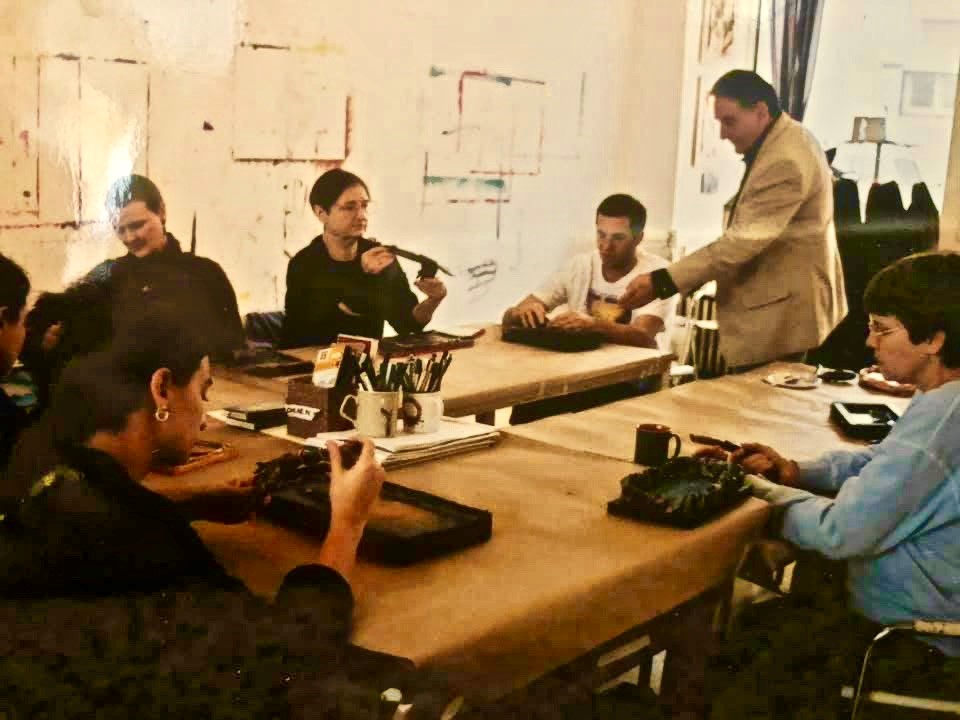
Don teaching at SAIC
After one or two encounters with this pillar of a man, anyone would understand he firmly believed in several strongly held principles. Art is a process, and he believed in that process from the core of his being. Art speaks for itself and those who view and make it need to learn how to listen to its unerring voice. And fundamentally he believed that everyone could, and needed to make art. I spent hours sitting with him in his studio, long after I graduated, working out solutions and relishing new terrains in our beloved field. He didn’t just offer answers, he fostered a process of critical thought that would help others find their own process. That process was one of deciphering the language inherent in the personal marks made by humans. He made me feel like whatever was on my mind was of first level of importance to him. All my own voices and those of my clients, felt heard. I’d walk away from his studio feeling special, but what I’d eventually discover was he had many, many such relationships. From my first encounter with Don Seiden, when interviewing for graduate school in 1987, till his last note to me, in his clear hand, a week before his death, he will always and forever, remain special to me.
Dayna Block MAAT, ATR
Don is the most beloved human I’ve encountered. Having time with Don was always a blessing. He was my professor at SAIC. He was my mentor, friend, supporter, and fellow artist at Open Studio Project. He even encouraged my daughter to get her MFA and become an Artist. I treasure the time I had with him and his art in my home. Don is a bright light and set a beautiful example of a loving creative way to engage in the world.
Robert Caswell, ATR-BC, LPC
When I first saw his home and all it contained, I had never seen anything like it. But I also somehow understood it completely. It made sense to me on some otherworldly level.
Carrie Eizik, ATR-BC, LCPC,
A well known artist and educator, Don always seemed to me to just be Don. Always friendly, open, present, he radiated kindness. I met Don in 1983 when I interviewed with him to become part of the Art Therapy program at the School of the Art Institute. I was feeling very shy and nervous that day, but he made me feel at ease with his own ease. It took me four years to earn my master’s degree, so I was lucky to have him for a teacher for all those years. One day, as he and I moved through the school cafeteria line, he asked me, “So, when DO you plan to graduate Carrie? You know you DO have to graduate.” Part of the reason for my slow progress was my life situation related to finances and parenting. But I have to admit that part of it was because I didn’t want the experience to end. Don was an artist through and through, in the truest and best sense of the word. His ceramic birds that he placed in the trees in a park near the lake is a wonderful example of that. He placed them there and then watched joyfully as others discovered them. He didn’t want recognition, he wanted the joy of seeing that encounter. I think that was how he taught, joyfully watching us learn and discover. He was and will always be, an inspiration to me.
Linda Lee Goldman, MEd, ATR-BC
Don was my first major exposure to Art Therapy in the first class he taught at The Art Institute in Chicago. I believe that every student loved him as I did, as well as appreciated his kind empathic teaching approach to our art making with clients. He introduced us to materials as a way to be authentic. I will always remember the first day of class when he had us look in our purses to find “stuff” from which to make art. He shared himself and his personal art making process with us, in a way that gave us courage to create authentic art and assist our clients to do so. His spirit was so strong and will live on with all of us, his students, as well in the books that he wrote and the amazing art he made.
Karin Grear, OT
I met Don when I was doing my clinical at Rush. He was always so warm and kind to me and everyone I saw him encounter. It is this quality that made the patients feel comfortable to attend and participate in his Art Therapy sessions regardless of their possible apprehension with doing art. He was so highly regarded by them as well as by the staff and physicians. What a blessing to have met him!
David R. Henley, ATR
In my 7 years working with Don, one memory sticks out in my mind.
During his sabbatical exhibition he had created this sculpture, which represented the murky beginnings of creation. My son who was at the opening and around 13 at the time approached him and said something to the effect:
“Mr. Seiden, that’s just how I’ve always imagined the beginning of the world”. I caught Don’s eyes welling up, having received the ultimate compliment and critique from another perceptive visionary young man.”
Katie Kunkel Kamholz MA, ATR-BC, LCPC
Thank you, Don, for showing me what it is to truly sit with, to witness, to hold space for another person and their art. Because of your teaching, modeling, and living in this way, I am able to try and do it for others as well. The love that you gave us will continue to ripple out forever.
Sarah Laing, MAAT, ATR
I am deeply saddened, but immensely grateful to honor the life of Don Seiden. Don was my professor at the School of the Art Institute of Chicago, a steadfast mentor for myself and many of my peers. He embodied the spirit of “Art as Integral to Life.” From Don, I learned to use materials to manifest insight, artistic behaviors, and genuine kindheartedness. I will always remember watching Don at the Lincoln Park Zoo on a quiet morning patiently observing gorillas. He was attuned to the natural world and his wide range of impactful artwork reflects his profound sincerity. Despite living in an urban environment, Don created an inspirational menagerie of discovery at his Rogers Park home and studio. This treasure inspired generations of students and artists.
As executive director of Open Studio Project Don was a long-time friend and advisor. Don attended our classes for many years demonstrating his dedication to his practice as an artist. He was on our founding board and frequently attended our exhibits. We honor Don every year at our annual benefit, Artopia, with an award that embodies his commitment to the transformative healing power of art. Our sculpture workshop was inspired by Don’s famous technique of tin foil and tape. We will continue to share Don’s books and teachings in our practices. Don has always been highly regarded in the Chicago art community and his legacy will continue on. I encourage you to support the family’s request to make art in his honor.
With much love and admiration for Don. My condolences to Jackie and the rest of the Seiden family. May he rest in artful peace.
Cathy Moon, MA, ATR-BC
I have fond memories of taking SAIC art therapy students from my Materials & Media classes to visit Don’s home and studio. We would take public transportation to his neighborhood of Rogers Park and walk to his house. As we walked, I told the students they would know which house was Don’s because it stood out from the other houses in the neighborhood. And I was right, they always knew which one was his! The wooden sided house was painted in pastel colors, alternating on the wood panels to give a striped effect. Don would greet us at the door and welcome us into his home. He and his wife Jackie would have a buffet of snacks waiting for us.
The interior of the house itself is hard to describe in words, but it was magnificent! It was a four-story work of art, from the attic to the basement. Don’s sculptural works permeated the space, from small painted birds made out of foil and masking tape, to wall-mounted skeletal figures, to a life-sized rhinoceros in their back yard that was also made out of foil, tape, and paint. Jackie, also an artist, created installations in every room of the house, and in every nook contained within those rooms. Her overall aesthetic was what I would describe as a combination of magical and disturbing. The walls were painted with pastel pink and green paint into which she had mixed glitter, so the place sparkled. But some of the installations–like the one in the attic that was comprised of twenty or more antique dolls in various stages of dress, each laying in one of the open vintage suitcases placed about the room–cast a vaguely macabre air to the environment.
The separate studio, which was where Don worked, was like many artists’ studios, full of both completed work and works-in-progress. What made this studio visit special was hearing Don talk about his work. He did so with his characteristic openness, authenticity, gentleness, and humility. He talked about how making work led to personal insights and helped him navigate the challenges of his life, and in doing so provided a wonderful example of an artist-art therapist to the visiting students.
The home/studio visit would end with everyone gathered together, eating snacks, and hearing stories from Don and Jackie. The two of them shared narratives about themselves as individuals and about their lives together, all with remarkable candor and generosity. I remember one time when Jackie said that their home-as-art-installation was, overall, a depiction of the inside of their bodies, their true selves. And that seemed about right. Their art and the words they spoke were raw and honest and full of life. I feel very fortunate to have been among those who visited this wondrous place, and among those who can call Don Seiden their beloved art therapy mentor.
Don and Jackie and their home
Takeo Nagasaka, MAAT
Don would give away a chick made with tin foil and masking tape, his trade mark technique, to every MAAT student of SAIC who made a field trip visit to his house. To me, those cute little chicks turned out to be the most inspiring legacy of his, literally as well as metaphorically. My visit to his pink eccentric house filled with his creatures taught me to embrace the mantra of “think outside the box” and the identity as an artist in the practice of art therapy, and the tape and foil chicks represent the legacy I inherited from him. My professional career began at a nursing home in Chicago, and I had the residents make tape and foil sculpture. Almost without exception, every single sculpture that the older adults made turned out so lovely and cuddly. Don came to the reception of the art exhibit at the nursing home one time, and I was so proud of the senior’s art work. Now in my native land of Japan, I introduce Don’s tape and foil technique to the professionals who work with seniors from time to time at my workshop. Surely, Don’s legacy will live on the other side of the world. I miss you and thank you, Don.
M. Ryan Noble, MAAT, ATR
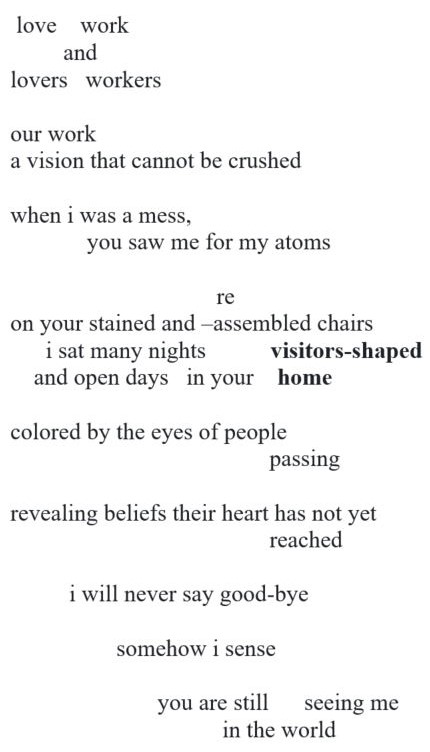
Lesley Hawley Reagan DAT, ATR, LCPC
20 years ago I was in Don Seiden’s art therapy studio class at SAIC. At the time I was working with terminally ill kids and teenagers and I was making art urgently and voraciously to process my experience. Every week Don would make his way around the room sitting with each of us and our art. Don would sit with me and my art. He would breathe with me with tears in his eyes … he would shake his head up and down… “yes”! I was forever moved by his presence sitting there and breathing with me witnessing my experience through my art steadily week after week. This silent steady witness was one of the greatest teachings I have received.
Don’s spirit lives through my art therapy practice and within my presence when I witness the art of others and breathe in and out with them simply and profoundly. I’m forever grateful for Don’s life and legacy.
Virginia O. Roeder MFA, ATR
I met Don Seiden the summer of 1986, when I was accepted to the Art Therapy Program at SAIC. It was HIS program. He made it fascinating. He was truly a great man and great teacher.
Suellen Semekoski ATR,BC, LCPC
Don Seiden was a friend, mentor and exemplar who authentically lived the fine line between art and life. As an artist and art therapist he taught from both sides of that line. He offered a way to translate the absurd beauty of humans believing there is actually a separation between art and life. He taught the importance of art therapists translating an appreciation of the aesthetic of living. The extraordinary could be found the ordinary in both seeing and living life, creatively. Problems in art were like problems in life. Problems in life were like problems art. Solutions to problems are never guaranteed but the aesthetic of living offers hope because it is literally in our hands.
Don was one of my tugboats. Few people have had such a direct impact on the direction of my life. When we first met I was the president of the Illinois Art Therapy Association (IATA) and was presenting our annual conference held at the Museum of Contemporary Art. He introduced himself afterwards and encouraged me to apply for a teaching position at SAIC. For every reason I gave him that it simply would not work, he gave me two that it would. He pulled me to a new harbor and simultaneously out to an open sea of learning and teaching. When students would come up against themselves and get lost, I would draw upon his steady patience. He helped me find my compass and likewise I might help them find theirs.
In my early years of teaching, I would greet him on both good days and bad days, and joke “Don this is your entire fault”! He would roll his eyes, chuckle and offer a hug. I began taking undergrad students to Don and Jackie’s to experience that rare, seamless space between art and life in their studio/home. Art and artifacts of living combined to make installations in every room, around every bend. Students came away inspired, challenged, giddy, joyous and at times confused, but never unchanged. Learning in their home was a welcoming, full sensory experience.
After he retired, I would greet him “Don when folks look up mensch in the dictionary they will find your picture.” He would roll his eyes, chuckle and offer a hug. Only I wasn’t joking and in that seamless place between humor and truth my gratitude lives. Thank you Don for everything.
Chris Spaletto MAAT, ATR
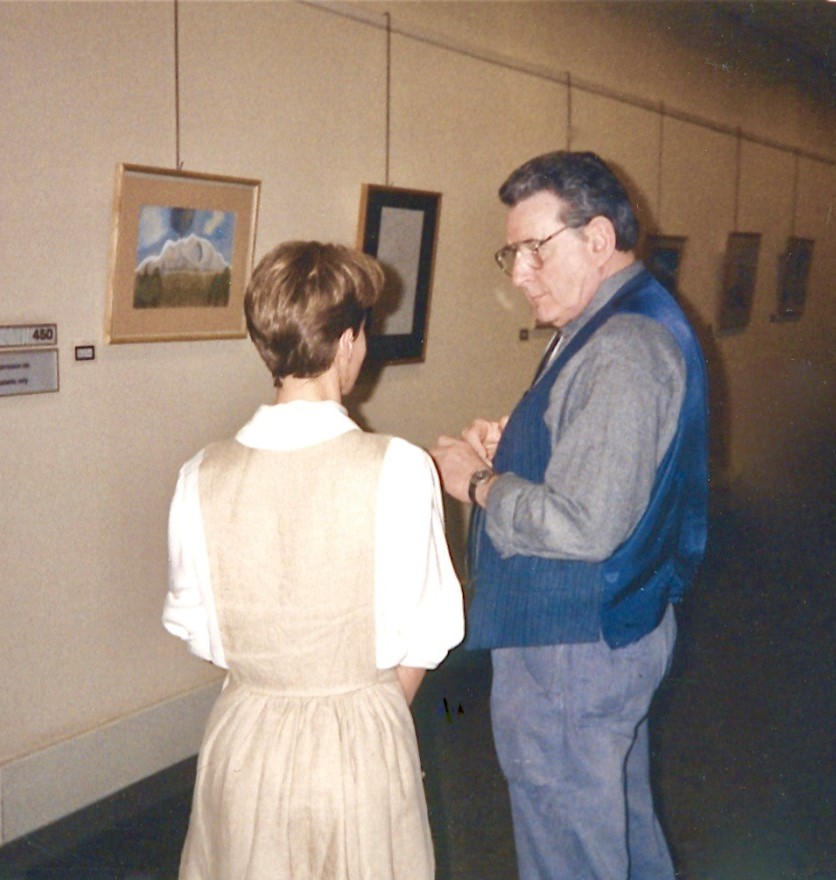 I was fortunate to be mentored by a ground-breaker in the field of Art Therapy. I was a student in the first graduate cohort in Art Therapy at the School of the Art Institute in Chicago. Don Seiden was my mentor. I remember him saying to me, “Chrissy, I’m counting on you. You’ll be in the first class to attend courses with the medical students at Rush University Medical School. I gave the television away. I hit the books. I was determined not to let him down but I had no idea how to do that. We had to do clinical rotations and I remember the risk I took in asking Don if I could do my rotations with him. I was a green kid. I had no idea what I was doing. Don said yes. What did he see in me? I still do not know. But whatever he did see in me grounded my desire to learn, grounded my passion to connect, grounded my ability to understand the metaphor of art therapy he was crafting. He personified what it means to mentor.
I was fortunate to be mentored by a ground-breaker in the field of Art Therapy. I was a student in the first graduate cohort in Art Therapy at the School of the Art Institute in Chicago. Don Seiden was my mentor. I remember him saying to me, “Chrissy, I’m counting on you. You’ll be in the first class to attend courses with the medical students at Rush University Medical School. I gave the television away. I hit the books. I was determined not to let him down but I had no idea how to do that. We had to do clinical rotations and I remember the risk I took in asking Don if I could do my rotations with him. I was a green kid. I had no idea what I was doing. Don said yes. What did he see in me? I still do not know. But whatever he did see in me grounded my desire to learn, grounded my passion to connect, grounded my ability to understand the metaphor of art therapy he was crafting. He personified what it means to mentor.
But then I also recall navigating my way through a labyrinth of the corridors and stairways to find the hospital auditorium where Don would be giving a presentation to the Department of Psychiatry. I was an hour early. I wanted to arrive early out of respect for Don, and to find a good seat. Opening the door at the rear of the auditorium I saw Don in the front center row, facing the screen above the stage – slide carousel loaded. As always, Don sat contemplative, ready and conscious of knowing that each presentation was a critical moment to explain the relationship of art-making and how this can interface with psychiatry.
This is a memory that has remained with me. Don was as meticulous, and prepared, as he was spontaneous, and humble. He was an artist, and a teacher who possessed great strength. He balanced his charisma with empathy, never failing to give to his students. He could see into us, inspire us, help us realize our own strengths. He always made us feel that he was present with us. What a gift to have learned from him, to be mentored by him, and walk down the trail he laid out for all of us.
Thank you, Don.
Image: Chris Spaletto & Don at the first public exhibit of patient art at a Rush
Holly Wherry, ATR-BC, LPC-S
He taught me that you could be an adult and still glue glitter on your walls.
Heidi Seiden Wodrich MA, LCPC, NCC
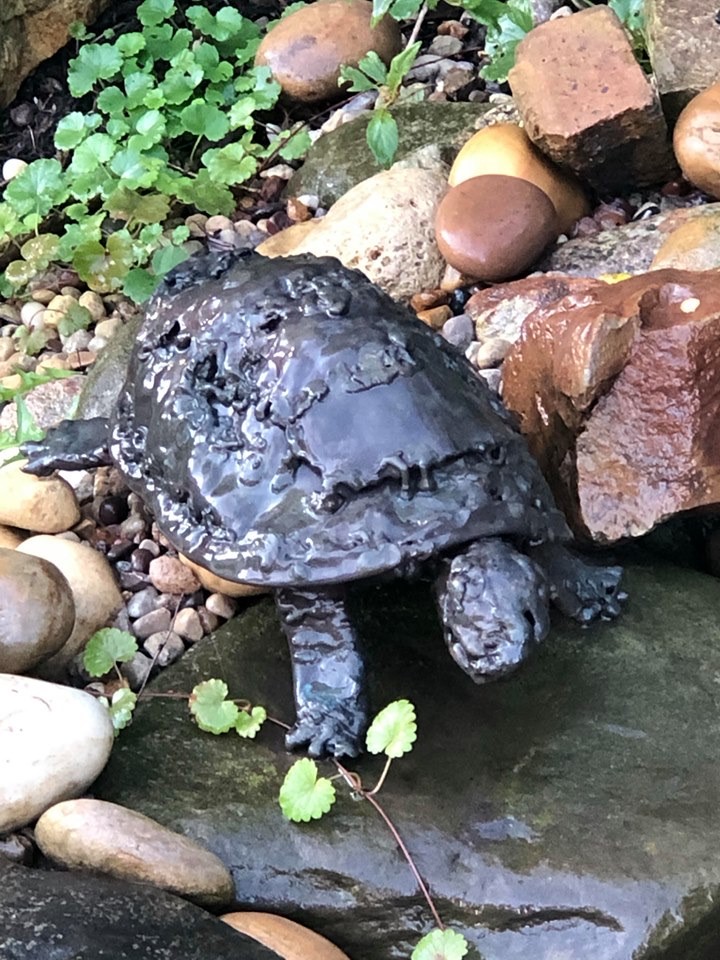 My Dad and I always had a kind of synchronicity, a really warm energy or ‘rhythm’ to our communications. When one of us would call the other, it was just ‘time’ and he would always say, “our rhythms are working”.
My Dad and I always had a kind of synchronicity, a really warm energy or ‘rhythm’ to our communications. When one of us would call the other, it was just ‘time’ and he would always say, “our rhythms are working”.
One of my favorite Dad memories: Around 18 years ago, Don had reached the end of his welding era, as he had decided that it had become a bit too dangerous to continue at his age. Around that time, I was building a little pond in my backyard and was telling my Dad about it on the phone. I told him that I thought it needed a turtle… no idea why I wanted one… it was kind of an impulsive statement. I asked him if he could make one for me at some point. He responded with curiosity and said he would give it some thought. This was on a Tuesday, and I was going to see him that weekend.
When I arrived at his house, after the usual hugs and catching up, he left the room and returned with a gift box and handed it to me. I opened it and it was a beautiful welded turtle! I was shocked! I knew he wasn’t welding anymore. I asked him “How????” He said that sometime back he’d gotten an urge to weld a turtle, he’d had no idea why, but he did it anyways… and when I asked him for a turtle that day, he then figured out exactly why he had made it.
Image: Turtle sculpture by Don
Works by and about Don Seiden
Books
Cassidy, M. (2006). The Magic Basement: Memories of the School of the Art Institute of Chicago. Trafford.
Davis, A. & Seiden, D. (2013). Art Works: How Making Art Illuminates Your Life, Chicago, IL: Ganesha Books. https://artworksthebook.com/order/
Hurwitz, A. (Ed.). (1972). Programs of Promise: Art in the Schools. New York: Harcourt Brace Jovanovich.
Meilach, D. & Seiden, D. (1966). Direct Metal Sculpture: Creative Techniques and Appreciation. New York: Crown Publications.
Seiden, D. (2001). Mind over matter: The uses of materials in art, education, and therapy. Chicago, IL:Magnolia Street.
Seiden, D. (2007). Artobiography. (2007) Chicago, IL: Fisheye Graphic Services. https://www.amazon.com/Artobiography-Don-Seiden/dp/1424306248/ref=sr_1_2/102-7716911-0888925?ie=UTF8&s=books&qid=1182782814&sr=8-2
Stevens, J. (2011). An Artist’s Life: The Life and Work of Don Seiden. Blurb books. https://www.blurb.com/b/2142234-an-artist-s-life
Articles
Leonhart, M. D. Rothberg, R. M., & Seiden, D. (1984). Artwork of cystic fibrosis patients, Art Therapy: Journal of the American Art Therapy Association, 1(2), 68-75, DOI: 10.1080/07421656.1984.10758750
Vick, R. M. (1996). An interview with Don Seiden, Art Therapy: Journal of the American Art Therapy Association, 13(3), 191-197, DOI: 10.1080/07421656.1996.10759219
The Healing Arts: Don Seiden’s creative approach to therapy (2000, by Mike Sula) https://www.chicagoreader.com/chicago/the-healing-arts/Content?oid=902139
Cover Art
Seiden, D. (2003). The Family. Art Therapy: Journal of the American Art Therapy Association, 20(2)
Andrus, M. (2007). A Portrait of Don. Art Therapy: Journal of the American Art Therapy Association, 24(1)
Videos
Don Seiden’s Secret for Slowing Down Time (2012, Nancy Bechtol) https://www.imdb.com/videoplayer/vi3044976409
Don and His Birds (2014, Mary Andrus) http://www.youtube.com/watch?v=aK60GwOtESg
Don Seiden: Art Therapist (2008, by Studio Skylight) https://vimeo.com/119955493
Going the Distance: Don Seiden—Artist, Teacher, Therapist
by Bruce Moon, Producer and Director Length: 19 minutes Lunar Productions, 2012
Available from Lunar Productions, 305 Dunbar Road, Mundelein, IL 60060, in DVD format, $10.
Website
http://www.donseiden.com/index.htm

